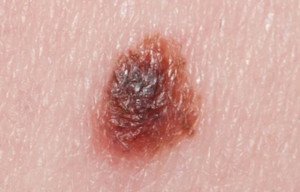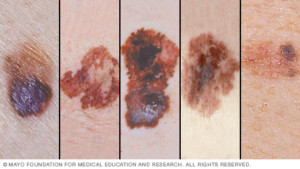
New moles in older age are cause for concern, according to many dermatologists.
What if a newly discovered mole after age 40 looks normal?
Should you have a new mole examined anyways?
Dr. Monica Halem, MD, a dermatologic surgeon who specializes in skin cancer surgery, laser and cosmetic surgery, answers some important questions you may have.
Dr. Halem: Yes, if someone develops a new mole they should have it looked at at any age even if they think it looks benign.
Dermatologists have a special instrument called a dermatoscope where they can look closer at the pigment network than with the naked eye.
We are trained to spot certain features that can tell us if the lesion might be malignant.
The only way to definitively know is to do a biopsy if we are suspicious. Almost 100% of melanoma is curable if caught early enough.
Should you keep an extra close watch even if the doctor says it looks benign?
I would recommend that everyone watch their moles carefully.
There is the ABCDE’s of melanoma. When they check their moles they should look for the following:
A = Asymmetry. If you cut your mole if half, you want to make sure both sides are symmetric
B = Border. You want to make sure the border is regular
C = Color. You want to look for moles that are “black” or multicolored.
D = Diameter. Anything bigger than 6mm or a pencil head eraser.
E = Evolution. Anything that is changing over time, increasing in size or bleeding.

Is there a time span that, after which the new mole still appears normal, one can cease worrying that it might one day become melanoma?
Or will it always be at higher risk of becoming melanoma since it appeared during middle age?
No, there is no amount of time that can pass for a person to not be concerned.
I would not recommend that patients be anxious about their moles, but I would recommend monthly skin exams with the guidelines above.
Monthly exams followed by a yearly dermatologic exam and sooner if patients are concerned about certain spots, is adequate for surveillance.

Shutterstock/Image Point Fr
Should every new mole over age 40 be removed no matter what?
There is no need for anxiety. Follow the recommendations above as a guideline.
What percentage of new moles in men and women age 40-50 eventually become melanoma?
There are no statistical data on this. There are many different factors that cause a mole to turn into melanoma.
Most of these are still be studied. What we know now, is that it is multifactorial, including but not limited to genetics and sun exposure.
One American dies of melanoma every hour. That to me is not hype. If patients follow the recommendations above that should be more then adequate.
Is there data on what percentage a new mole will become melanoma?
There is no data on this.
As for the new moles that turn into melanoma, is there a time passage that this usually occurs?
If the spot is destined to become melanoma in middle age, does this change usually occur within a certain time frame from the “birth” of the spot?
No data on this at all. There is no way to tell in terms of timeline when a mole turns into melanoma.
Say an individual decides to just “watch” a benign-looking new spot.
If he waits for it to start changing, is it possible that the day he first notices it changing (assume he checks every month), it might have gone from normal to stage 2 melanoma?
Or is it usually the case that if one diligently monitors it, he will be able to perceive normal-to-stage 0 (very early melanoma) changes?
The latter.
If a new mole is destined to become melanoma, can its size be an indicator?
Can one assume, “Well, I don’t have to worry about it because it’s half a millimeter?”
No, there are other guidelines besides size. See above.
If a new tiny speck is a mole, how fast is it expected to increase in diameter if it stays benign?
There is no data on rate of growth.
 Dr. Halem, Founder and Medical Director of The New York Dermatologic Surgery Cosmetic Laser Center, has devoted a decade to clinical research, conducting trials that have advanced cosmetic and surgical dermatology.
Dr. Halem, Founder and Medical Director of The New York Dermatologic Surgery Cosmetic Laser Center, has devoted a decade to clinical research, conducting trials that have advanced cosmetic and surgical dermatology.
 Lorra Garrick has been covering medical, health and personal security topics for many years, having written thousands of feature articles for a variety of print magazines and websites. She is also a former ACE-certified personal trainer.
Lorra Garrick has been covering medical, health and personal security topics for many years, having written thousands of feature articles for a variety of print magazines and websites. She is also a former ACE-certified personal trainer.









































